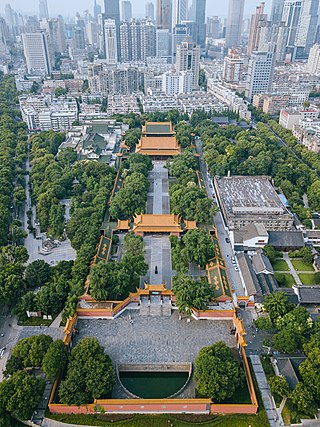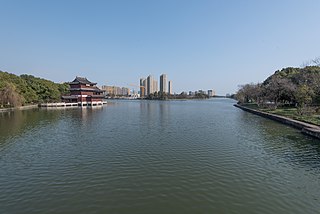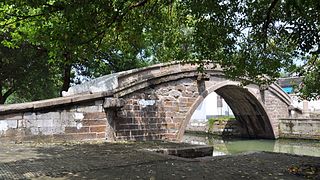See also
- Gangnam (disambiguation), Korean equivalent
- Ying Nan, a fictional character in the Marvel Cinematic Universe
- 江南 (disambiguation)
Jiangnan is the region south of the lower reaches of the Yangtze River in China.
Jiangnan may also refer to:

Nanjing, alternatively romanized as Nanking, is the capital of Jiangsu province of the People's Republic of China. It is a sub-provincial city, and a megacity. The city has 11 districts, an administrative area of 6,600 km2 (2,500 sq mi), and a population of 9,423,400 as of 2021. Situated in the Yangtze River Delta region, Nanjing has a prominent place in Chinese history and culture, having served as the capital of various Chinese dynasties, kingdoms and republican governments dating from the 3rd century to 1949, and has thus long been a major center of culture, education, research, politics, economy, transport networks and tourism, being the home to one of the world's largest inland ports. The city is also one of the fifteen sub-provincial cities in the People's Republic of China's administrative structure, enjoying jurisdictional and economic autonomy only slightly less than that of a province. Nanjing has been ranked seventh in the evaluation of "Cities with Strongest Comprehensive Strength" issued by the National Statistics Bureau, and second in the evaluation of cities with most sustainable development potential in the Yangtze River Delta. It has also been awarded the title of 2008 Habitat Scroll of Honor of China, Special UN Habitat Scroll of Honor Award and National Civilized City. Nanjing is also considered a Beta city classification, together with Chongqing, Hangzhou and Tianjin by the Globalization and World Cities Research Network, and ranked as one of the world's top 100 cities in the Global Financial Centres Index.

Fujian is a province on the southeastern coast of China. Fujian is bordered by Zhejiang to the north, Jiangxi to the west, Guangdong to the south, and the Taiwan Strait to the east. Its capital is Fuzhou and its largest city by population is Quanzhou, other notable cities include the port city of Xiamen and Zhangzhou. Fujian is located on the west coast of the Taiwan Strait as the closest geographically and culturally to Taiwan. Certain islands such as Kinmen are only approximately 10 km (6.2 mi) east of Xiamen in Fujian.

Jiangnan is a geographic area in China referring to lands immediately to the south of the lower reaches of the Yangtze River, including the southern part of its delta. The region encompasses the city of Shanghai, the southern part of Jiangsu Province, the southeastern part of Anhui Province, the northern part of Jiangxi Province and the northern part of Zhejiang Province. The most important cities in the area include Anqing, Changzhou, Hangzhou, Nanjing, Ningbo, Shaoxing, Suzhou, Wuxi, Wenzhou, Yangzhou and Zhenjiang.

Xiao is a Chinese-language surname. In the Wade-Giles system of romanization, it is rendered as Hsiao, which is commonly used in Taiwan. It is also romanized as Siauw, Shiao, Siaw, Siew, Siow, Seow, Siu, Shiu or Sui, as well as "Shaw" in less common situations, inspired by the transliteration of the surname of notable figures such as Irish playwright George Bernard Shaw and English actor Robert Shaw. It is the 99th name on the Hundred Family Surnames poem.

The Viceroy of Liangjiang, fully named in Chinese as the Governor-General of the Two River Provinces and Other Local Admirals, in Charge of Military Affairs, Food and Wages, Management of Rivers, and Administration on Nanhe Affairs, was one of eight regional Viceroys during the Qing dynasty. The Viceroy of Liangjiang had jurisdiction of military, civil, and political affairs over then Jiangnan Province and then Jiangxi Province. The position was set up in 1647 and abolished in 1912.

Nanxun is a historic town in Nanxun District of Huzhou, Zhejiang, China. As of the 2007 census it had a population of 119,300 and an area of 141-square-kilometre (54 sq mi).

Nanjing Library is the third-largest library in China with over 10 million items. It houses important scientific, cultural and arts literature relating to Jiangsu province and other national historical records such as ancient Chinese and foreign publications. As located in the ancient capital Nanjing, the library contains 1.6 million ancient books and 100,000 volumes of books, documents and manuscripts dating from the Tang dynasty to the Ming dynasty.

The Chaotian Palace, is located in Nanjing, China. It was built as an imperial palace in the Ming dynasty, and today it is known as the Nanjing Municipal Museum. Chaotian Palace area has the largest preserved traditional Chinese architectural complex in Jiangnan.
Linxiang is a county-level city in Hunan province, China, it is under the administration of the prefecture-level city of Yueyang. Linxiang is located at the northeastern edge of Hunan province, on the southeastern (right) bank of the Yangtze River, which lies to the east of the city proper. Linxiang is bordered to the northwest and the north across the Yangtze by Jianli County and Honghu City of Hubei, to the east by Chibi City, Chongyang and Tongcheng Counties of Hubei, to the south and southwest by Yueyang County, to the west by Yunxi District. It covers an area of 1,718 km2 (663 sq mi), as of 2015, it had a registered population of 537,500. The city has 3 subdistricts and 10 towns under its jurisdiction. the government seat is Chang'an (长安街道).
江南 may refer to:

Jiangnan Circuit or Jiangnan Province was one of the major circuits during the Tang dynasty, Five Dynasties period, and early Song dynasty. During the Tang dynasty it was known as Jiangnan Dao (江南道), and during the Song dynasty Jiangnan Lu (江南路), but both dao and lu can be translated as "circuit". In 1020 it was divided into 2 circuits: Jiangnan East Circuit and Jiangnan West Circuit.

The Jiangnan Examination Hall, near the Confucius temple, is located in the southern part of Nanjing, Jiangsu Province, China. It is the largest examination hall for imperial examination in ancient China. It now houses the Imperial Examination Museum.
Hunan Jiangnan Automobile Manufacturing Co., Ltd., commonly known as Jiangnan Automobile is a Chinese automobile manufacturing company established in 2001 and majority owned by Zotye from 2007 onwards, headquartered in Xiangtan. It went bankrupt, entered reorganisation in 2021 and was relaunched in 2022.

Jiangnan, formerly romanized as Kiangnan, was a historical province of the early Qing Empire. Its capital was Jiangning, from which it is sometimes known as Nanjing or Nanking Province. Established in 1645 during the Manchu conquest of Ming China, it administered the area of the earlier Ming province of Nanzhili, reaching from north of the Huai River—at the time the course of the Yellow River—to south of the Yangtze River in East China. Its territory was later divided into the separate provinces of Jiangsu and Anhui during the reign of the Qianlong Emperor (1736–1795), although the exact timing is disputed. Under the Republic and People's Republic of China, an area of Jiangsu also became the provincial-level municipality of Shanghai.
The Subei people, also known as Jiangbei People, are a Jianghuai Mandarin-speaking Han Chinese people of the Subei region.

The Eastern Zhejiang or Zhedong Canal, also known as the Hangzhou–Ningbo or Hangyong Canal, is a major canal connecting Hangzhou, Shaoxing, and Ningbo in northern Zhejiang, China. It runs 239 kilometres (149 mi), connecting the Qiantang, Cao'e, and Yong watersheds with Hangzhou's terminus for the Grand Canal and Ningbo's ports on the East China Sea. Since 2013, it has been officially considered the southernmost section of the Grand Canal itself.
The Jianghuai people are people from Jianghuai over the floodplains and the estuary of the Yangtze River region. The word Jianghuai is a geographical and cultural definition of the people group living in the historical Liangjiang (两江) area, southeastern Henan province, Suzhou, and the central region of Anhui province.

Jinze is a town in Qingpu District of Shanghai, China. As of the 2017 census it had a population of 60,800 and an area of 108.49-square-kilometre (41.89 sq mi). The town is bordered by two provinces, namely Zhejiang and Jiangsu. With convenient land and water transportation, it is an important transport hub linking Shanghai, Zhejiang and Jiangsu. It is surrounded by the towns of Shenta, Zhouzhuang and Jinxi on the northwest, Liantang Town on the southeast, Zhujiajiao Town on the east, and the towns of Dingshan and Dashun on the southwest.
Kiangnan 1894 is a 2019 Chinese animated film co-produced by SMG Pictures and Shanghai Zhongchuan Culture Media Co. It was scheduled released on September 27, 2019, and set in Shanghai during the late Qing dynasty. The theme song debuted at the CCG Expo 2019 in Shanghai in July.
Wang Jiafan was a Chinese historian specializing in economic and social history of China and Jiangnan regional history. He was a professor and doctoral supervisor at East China Normal University.